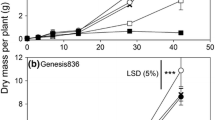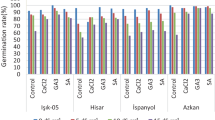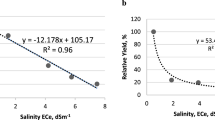Abstract
Aims
Chickpea (Cicer arietinum L.) is considered a salt sensitive species, but some genetic variation for salinity tolerance exists. The present study was initiated to determine the degree of salt tolerance among chickpea genotypes, and the relationship between salt tolerance and ion accumulation in leaves and reproductive tissues.
Methods
Three experiments were conducted in a glasshouse in Perth, Western Australia, in which up to 55 genotypes of chickpea were subjected to 0, 40 or 60 mM NaCl added to the soil to determine the variation in salt tolerance, and the association between salt tolerance and reproductive success. Pod and seed numbers, seed yield and yield components, pollen viability, in vitro pollen germination and in vivo pollen tube growth, were used to evaluate reproductive success. Leaves, flowers and seeds were sampled in the reproductive phase to measure the concentrations of sodium, potassium and chloride ions in these organs.
Results
When grown in soil with 40 mM NaCl, a 27-fold range in seed yield was observed among the 55 chickpea genotypes. The increased salt tolerance, as measured by yield under salinity or relative yield under saline conditions, was positively associated with higher pod and seed numbers, and higher shoot biomass, but not with time to 50 % flowering nor with the number of filled pods in the non-saline treatment. Pod abortion was higher in the salt sensitive genotypes, but pollen viability, in vitro pollen germination and in vivo pollen tube growth were not affected by salinity in either the salt tolerant or salt sensitive genotypes. The concentrations of sodium and potassium ions, but not chloride, in the seed were significantly higher in the sensitive (106 μmol g−1 DM of sodium and 364 μmol g−1 DM of potassium) than in the tolerant (74 and 303 μmol g−1 DM, respectively) genotypes. Sodium and potassium, but particularly chloride, ions accumulated in leaves and in pod wall, whereas accumulation in the seed was much lower.
Conclusions
Considerable genotypic variation for salt tolerance exists in chickpea germplasm. Selection for genotypes with high pod and/or seed numbers that accumulate low concentrations of salt in the seed will be beneficial.






Similar content being viewed by others
Abbreviations
- DAS:
-
Days after sowing
- DM:
-
Dry mass
- FDA:
-
Fluorescein diaceteate
- G x E:
-
Genotype by environment
References
Berger JD, Turner NC, Siddique KHM, Knights EJ, Brinsmead RB, Mock I, Edmonson C, Khan TN (2004) Genotype by environment studies across Australia reveal the importance of phenology for chickpea (Cicer arietinum L.) improvement. Aust J Agric Res 55:1071–1084
Berger JD, Ali M, Basu PS, Chaudhary BD, Chaturvedi SK, Deshmukh PS, Dharmaraj PS, Dwivedi SK, Gangadhar GC, Gaur PM, Kumar J, Pannu RK, Siddique KHM, Singh DN, Singh DP, Singh SJ, Turner NC, Yadava HS, Yadav SS (2006) Genotype by environment studies demonstrate the critical role of phenology in adaptation of chickpea (Cicer arietinum L.) to high and low yielding environments of India. Field Crops Res 98:230–244
Brewbaker JL, Kwack BH (1963) The essential role of calcium ion in pollen germination and pollen tube growth. Amer J Bot 50:859–865
Clarke HJ, Siddique KHM (2004) Response of chickpea genotypes to low temperature stress during reproductive development. Field Crops Res 90:323–334
Davies S, Turner NC, Siddique KHM, Plummer JA, Leport L (1999) Seed growth of desi and kabuli chickpea (Cicer arietinum L.) in a short-season Mediterranean-type environment. Aust J Exp Agric 39:181–188
Department of Agriculture and Food, Western Australia (2002) Soil groups of Western Australia. Resource Management Technical Report 248. http://www.agric.wa.gov.au/objtwr/imported_assets/content/lwe/land/tr246_part3.pdf. Accessed April 2012
El-Swaify SA, Pathak P, Rego TJ, Singh S (1985) Soil management for optimized productivity under rainfed conditions in the semi-arid tropics. Adv Soil Sci 1:1–64
Fang X, Turner NC, Yan G, Li F, Siddique KHM (2010) Flower and pod production, pollen viability, and pistil function are reduced and flower and pod abortion increased in chickpea (Cicer arietinum L.) under terminal drought. J Exp Bot 61:335–345
Flowers TJ, Gaur PM, Gowda CLL, Krishnamurthy L, Srinivasan S, Siddique KHM, Turner NC, Vadez V, Varshney RK, Colmer TD (2010) Salt sensitivity in chickpea. Plant Cell Environ 33:490–509
Furbank RT, White R, Palta JA, Turner NC (2004) Internal recycling of respiratory CO2 in pods of chickpea (Cicer arietinum L.): the role of pod-wall, seedcoat and embryo. J Exp Bot 55:1687–1696
Ghanem ME, van Elteren J, Albacete A, Quinet M, Martínez-Andújar C, Kinet J-M, Pérez-Alfocea F, Lutts S (2009) Impact of salinity on early reproductive physiology of tomato (Solanum lycopersicum) in relation to a heterogeneous distribution of toxic ions in flower organs. Funct Plant Biol 36:125–136
Heslop-Harrison J, Heslop-Harrison Y (1970) Evaluation of pollen viability by enzymatically induced fluorescence; intracellular hydrolysis of fluorescein diacetate. Stain Tech 45:115–120
Isbell RF (1996) The Australian soil classification. Australian Soil and Land Survey Handbook, Volume 4. CSIRO Publishing, Collingwood, Victoria, Australia
Krishnamurthy L, Turner NC, Gaur PM, Upadhyaya HD, Varshney RK, Siddique KHM, Vadez V (2011) Consistent variation across soil types in salinity resistance of a diverse range of chickpea (Cicer arietinum L.) genotypes. J Agron Crop Sci 197:214–227
Leport L, Turner NC, Davies SL, Siddique KHM (2006) Variation in pod production and abortion among chickpea cultivars under terminal drought. Eur J Agron 24:236–246
Ma Q, Behboudian MH, Turner NC, Palta JA (2001) Gas exchange by pods and subtending leaves and internal recycling of CO2 by pods of chickpea (Cicer arietinum L.) subjected to water deficits. J Exp Bot 52:123–131
Munns R, Tester M (2008) Mechanisms of salinity tolerance. Annu Rev Plant Biol 59:651–681
Samineni S, Siddique KHM, Gaur PM, Colmer TD (2011) Salt sensitivity of the vegetative and reproductive stages in chickpea (Cicer arietinum L.): Podding is a particularly sensitive stage. Environ Exp Bot 71:260–268
Singh BK, Pandey RK (1980) Production and distribution of assimilate in chickpea (Cicer arietinum L.). Aust J Plant Physiol 7:727–735
Turner NC, Davies SL, Plummer JA, Siddique KHM (2005) Seed filling in grain legumes under water deficits with emphasis on chickpea (Cicer arietinum L.). Adv Agron 87:211–250
Upadhyaya HD, Ortiz R (2001) A mini-core subset for capturing diversity and promoting utilization of chickpea genetic resources in crop improvement. Theor Appl Genet 102:1292–1298
Upadhyaya HD, Dwivedi SL, Baum M, Varshney RK, Udupa SM, Gowda CLL, Hoisington D, Singh S (2008) Genetic structure, diversity, and allelic richness in composite collection and reference set in chickpea (Cicer arietinum L.). BMC Plant Biol 8:106
Vadez V, Krishnamurthy L, Serraj R, Gaur PM, Upadhyaya HD, Hoisington DA, Varshney RK, Turner NC, Siddique KHM (2007) Large variation in salinity tolerance in chickpea is explained by differences in sensitivity at the reproductive stage. Field Crops Res 104:123–129
Vadez V, Krishnamurthy L, Thudi M, Anuradha C, Colmer TD, Turner NC, Siddique KHM, Gaur PM, Varshney RK (2012a) Assessment of ICCV 2 × JG 62 chickpea progenies shows sensitivity of reproduction to salt stress and reveals QTL for seed yield and yield components. Mol Breeding 30:9–21
Vadez V, Rashmi M, Sindhu K, Muralidharan M, Pushpavalli R, Turner NC, Krishnamurthy L, Gaur PM, Colmer TD (2012b) Large numbers of flowers and tertiary branches, and higher reproductive success increase yields under salt stress in chickpea. Eur J Agron 41:42–51
Acknowledgements
We thank the Council of Grain Grower Organisations (COGGO Ltd), the Australian Research Council (Linkage Project LP0776586), the Crawford Fund, The UWA Institute of Agriculture and Centre for Legumes in Mediterranean Agriculture at the University of Western Australia, the International Crops Research Institute for the Semi-arid Tropics, and Punjab Agricultural University for financial support. Dr J.S. Sandhu is also thanked for his support for this project.
Author information
Authors and Affiliations
Corresponding author
Additional information
Responsible Editor: Frans J. M. Maathuis.
Rights and permissions
About this article
Cite this article
Turner, N.C., Colmer, T.D., Quealy, J. et al. Salinity tolerance and ion accumulation in chickpea (Cicer arietinum L.) subjected to salt stress. Plant Soil 365, 347–361 (2013). https://doi.org/10.1007/s11104-012-1387-0
Received:
Accepted:
Published:
Issue Date:
DOI: https://doi.org/10.1007/s11104-012-1387-0




